Centers of Excellence (COEs) are your path to beating your competition – Part 2 (the Organization)
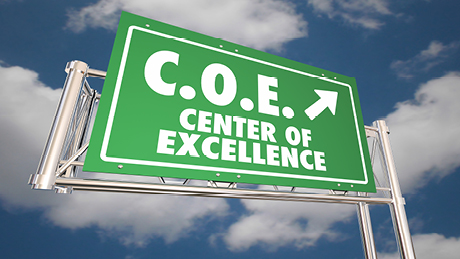
In this second installment, I will focus on:
- Providing a sample charter
- Providing examples of Guiding Principles
- Reviewing examples of Operating Models
- Recommending what LOBs to select first
- Roles and responsibilities that an Analytics Center of Expertise and Innovation (COEI) should include
- Functions and services that an Analytics COEI should provide
- An example of a mature Analytics COEI organization
- A more modest starting point for the Analytics COEI
- Growth areas for the Analytics COEI as more LOBs are supported
- Examples of actual costs allocations of the Analytics COEI
A recent PwC Survey found that leaders are extremely concerned about their organization’s rate of innovation. In fact, 44% of CEOs felt their speed of technological change was insufficient, and 32% of CEOs surveyed felt that they did not possess the availability of key resources with the right skills and experience.
KPMG found that 57% of CEOs are concerned that their organizations don’t have innovative processes to respond to rapid, unexpected disruptions and their speed to market falls short of expectations as a result.
In my first post on this topic, I covered the fundamental definition and reasons behind creating an Analytics COEI. It’s now time to fully explore the organization required to make it work.
The Analytics COEI will need a charter tailored to each customer’s needs and maturity, but fundamentally it needs to focus on the alignment of business requirements to technical capabilities:
The COEI organization focuses on the alignment of business analytical goals, drivers, strategies, and plans to the best practices, tools, and technological capabilities of the enterprise. The COEI organization will serve as a very experienced analytical extension of the enterprise LOBs, that strives to deliver better, timelier, more reliable business analytics and insights while freeing up business resources to return to their intended focus areas and away from data wrangling and preparation activities. The COEI will serve as a bridging organization that will facilitate the consolidation and fine tuning of the enterprise’s analytical functions and capabilities over time. The COEI drives the enterprise strategic focus on optimizing data analytics and value creation by bringing together, defining where necessary, and leveraging:
- Highly experienced SMEs in their respective fields and processes for capturing and processing business requirements and analytics demands
- Best practices in creating and presenting analytical results and clear key success factors, measures, and metrics
- Clear and ample communications about the Analytics COEI’s charter, responsibilities, and accomplishments, as well as expectations from the enterprise
- Training of its own staff as well as those in the LOBs it serves
- Enabling self-service data exploration and analytics while observing and enforcing data access and governance rules
You have seen some of these functions and responsibilities repeated throughout this blog, because they are important and fundamental.
The Analytics COEI also requires a set of Guiding Principles. These will vary somewhat between enterprises, but fundamentally:
- Standardize: one of the main purposes of an Analytics COEI should be to define and develop standards and best practices. This includes developing and documenting requirements capture templates, reporting and dashboard standards, and repeatable workflows, processes, and methodologies for all significant work efforts
- Define and measure performance with KPIs and specific metrics
- Guidance and governance for enabling self-service analytics
- Engage with decision-makers and leverage their experience and knowledge to help produce more valuable insights
- Leverage senior business stakeholders to build bridges between the business units/functions and the COEI data analytics team. They provide specific requirements and pain points and become your champions when you help address their specific business challenges
- Overcommunicate your accomplishments and achievements as well as how easy it was to engage the COEI. Communicate how your KPIs and measures have improved over time. Be specific and provide names and actual, quantitative results (how did the COEI impact the bottom line of specific LOBs)
- Leverage any existing enterprise and COEI assets, including:
- People (such as SMEs, processes, tools and technologies, existing knowledge), and relationships (such as specific customer or stakeholder contacts, vendor relationships and memberships, partnerships, and other enterprise groups such as LOB shadow IT groups)
- Models and code (including design patterns, data models, algorithms, templates, custom in-house developed tools, and utilities) and any other artifacts and policies (documents describing policies, guidelines, advice, industry best practices, organizational best practices, constraints, and considerations)
There are at least two Operating Models for COEIs that represent scope, capabilities, and supporting infrastructure differently. Each enterprise will need to tailor oneof these to their specific circumstances, but both of these offer good starting points.
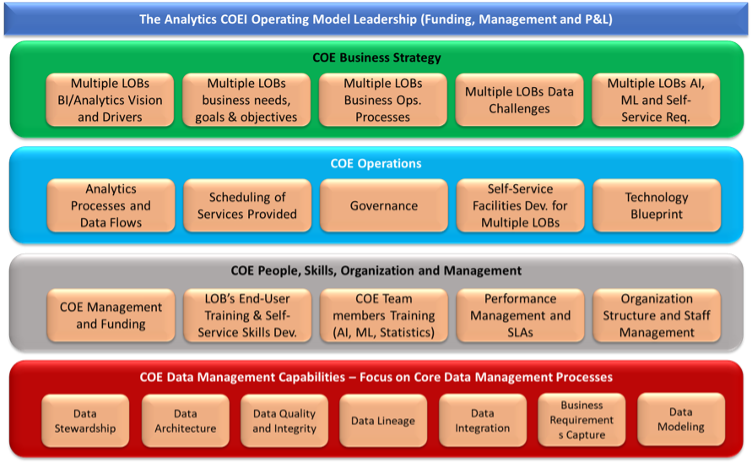
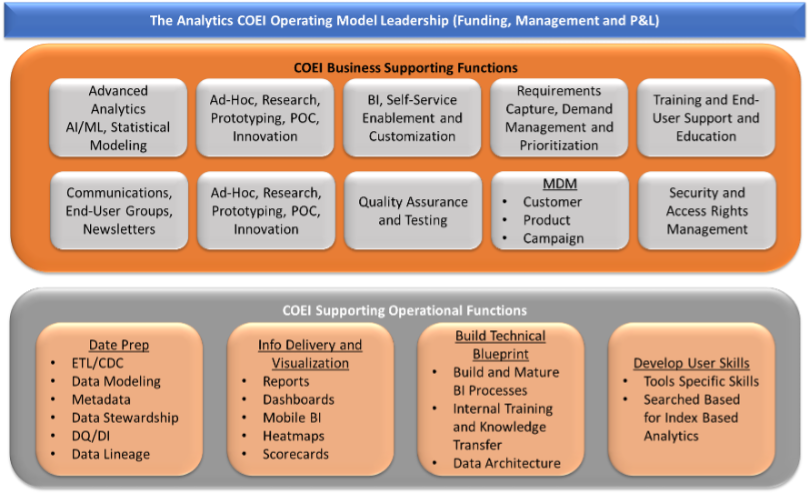
At this point, I will answer some specific questions that many of our customers have.
What LOBs should we start with?
The answer is always “depends, depends, depends” on many factors. I’ll use a large insurance customer as an example.
In my experience, I believe that for the first 12-18 months, your Analytics COEI should focus on the highlighted LOBs, or at least 1-2 of them. If possible, start with P&C and Life.
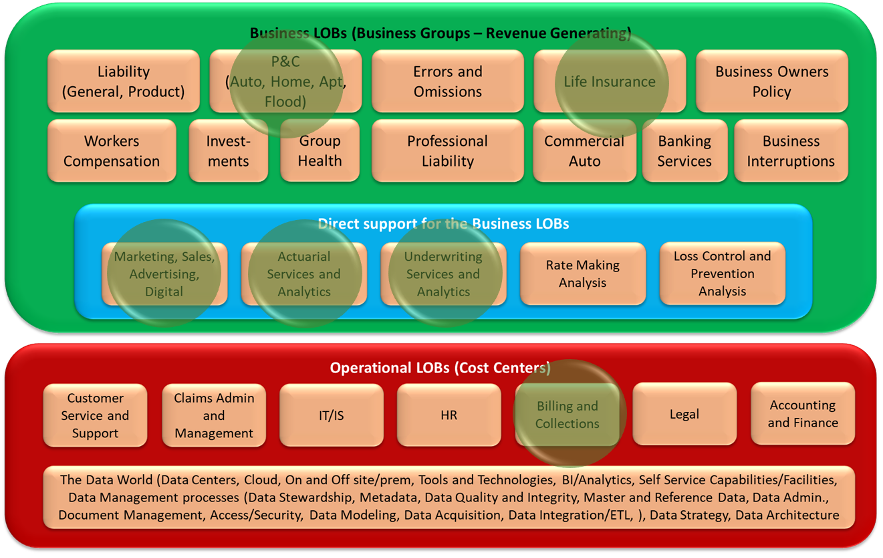
Not unlike other verticals, insurance companies have a general internal business and operations LOB structure that is very specifically designed to:
- Minimize losses and risk while increasing market share and Lifetime Customer Value
- Up/down and cross-sell their products
- Drive more business to their doors (currently many of these insurance companies also have a banking LOB)
- Develop highly specialized customer and product master data, 360, householding and segmentation capabilities
- Capture, manage and analyze very large amounts of traditional as well as unstructured, internal, and external data
Other enterprises focus their Analytical COEI efforts where they feel the greatest need or pain exists. If they have two LOBs that are experiencing major, reoccurring data quality, availability, and timeliness issues, they will use these as their starting point, and will often use additional data management COEI resources to supplement the Analytics COEI efforts to tactically address data and reporting challenges.
What roles and responsibilities does the COEI need to include, and what functions should it support?
Here are some Analytics COEI Roles and Responsibilities and functions/services examples:
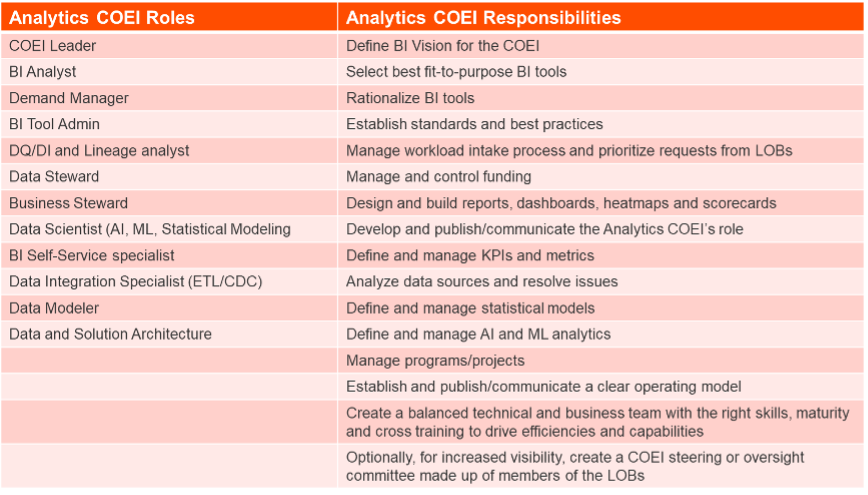
The COEI needs to be able to deliver these functions and services, as needed, better and faster than the LOBs can. Services and functions that an Analytics COEI needs to provide:
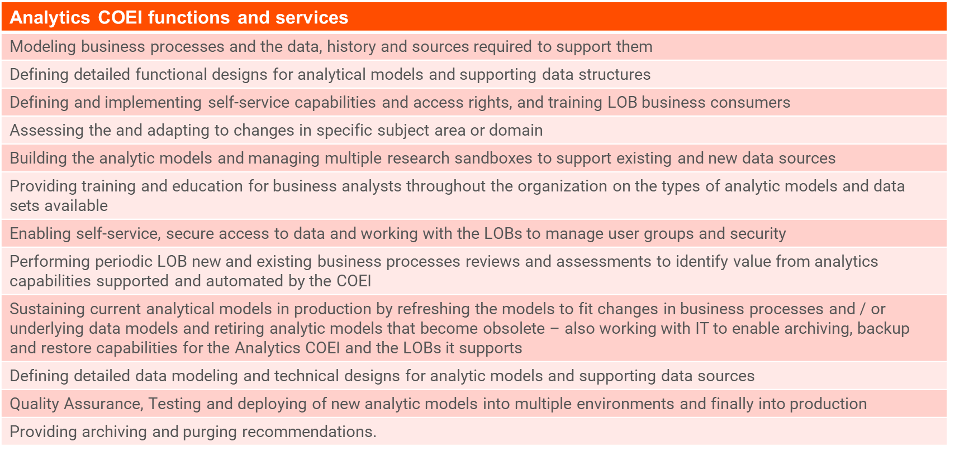
The next set of questions focus on the Analytics COEI organization.
What should a mature organization look like?
What is the minimum staffing you can start with?
What resources you need to consider adding as you add support for additional LOBs?
The Analytics COEI organization is implemented differently by each client. This is an example of a mature enterprise implementation (4–6 years). It outlines what resources are needed to support 2–3 LOBs and which resources could be shared or borrowed from IT and Data Management groups.
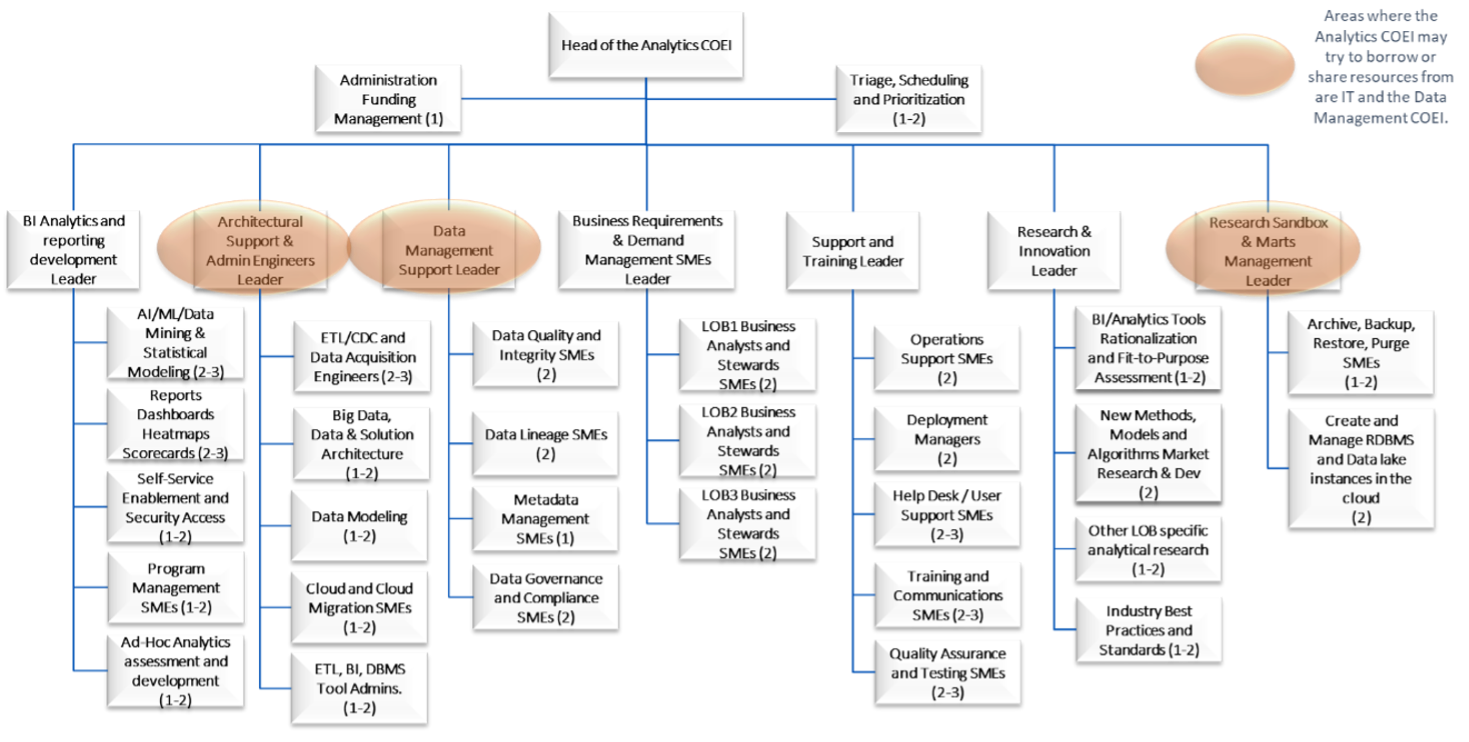
The Analytics COEI organization needs to expand as additional LOBs are supported. Here are guidelines to the areas you need to consider adding one or two additional FTEs to each time a new LOB is supported. As more LOBs are added, existing staff can be cross trained to support them. After the first 3-5 LOBs are supported, the size of the COEI should not increase much at all.
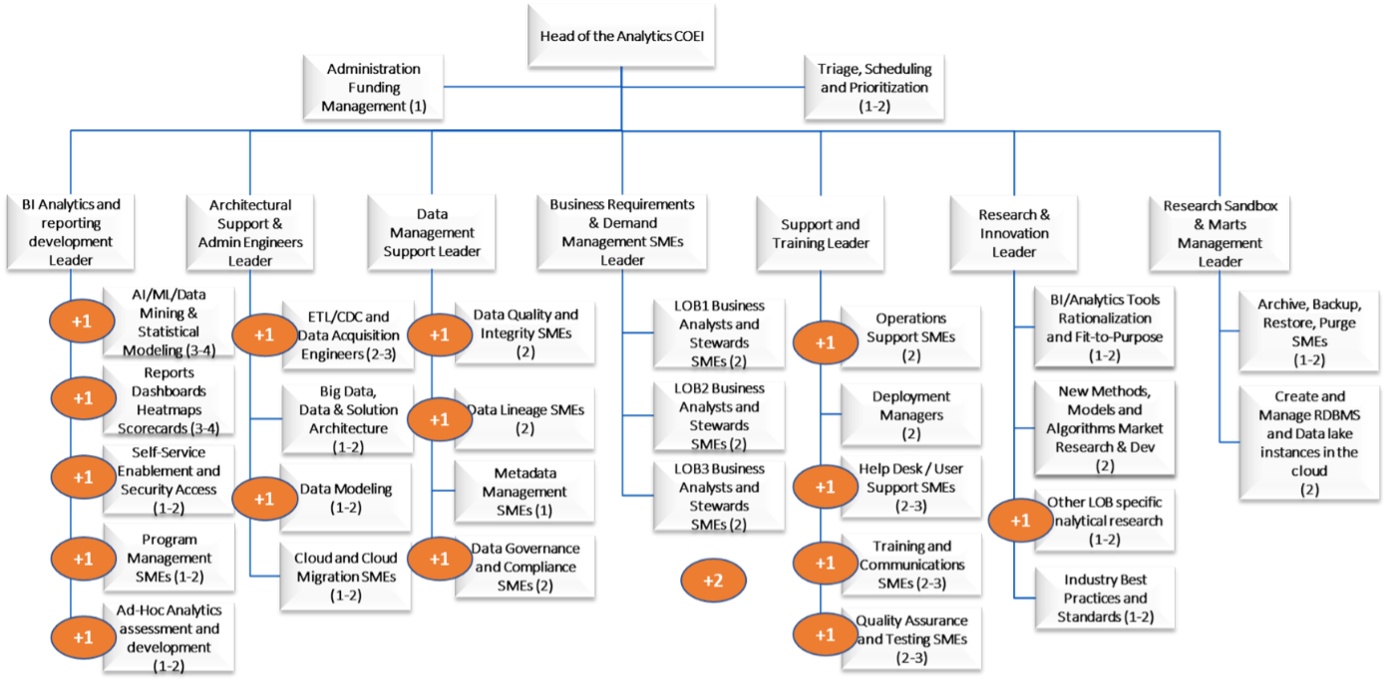
In my next and final post, I will answer a number of questions about where you can get the staffing and funding for the Analytics COEI, more specifically:
- Staffing and funding sources for the Analytics COEI
- Justifying and funding the Analytics COEI
- Positioning of the Analytics COEI
- Types of Analytics COEI implementations you should start with
And the experts agree:
- McKinsey learned that 60% of top-performing companies that leverage advanced analytics successfully have a “center of gravity” to drive their analytics efforts.
Critical point:
You need COEs. Focus on your Analytics and Data Integration COEs first if you can only tackle two. Many companies also focus on implementing a Data Management COE.
Need help partnering with your business stakeholders to drive more value, build a roadmap, build a COE, or design your data strategy and data governance programs and processes? Contact Informatica’s Advisory Services group for an initial consultation.








